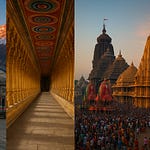Hidden amid the breathtaking landscapes of the Pulwama district in the Kashmir Valley lies a sacred jewel of India's ancient spiritual heritage — the Shiva Temple of Payer (historically Panwangam). Built over 1,500 years ago, this temple stands not just as a religious sanctuary but as a living testament to Kashmir’s early dynastic history, architectural innovation, and deep devotion to Lord Shiva.
Recognized today as a protected monument by the Archaeological Survey of India (ASI), the temple holds layers of historical, religious, and cultural significance that deserve wider recognition.
Origin and Foundation
The Shiva Temple of Payer was commissioned between 483 and 490 CE by Maharaja Narendraaditya, a prominent ruler from the early medieval Varman dynasty. This dynasty was known for fostering religious art, literature, and architecture, especially temples devoted to Hindu deities.
Uniquely, the Payer temple was constructed using only ten massive, meticulously placed stones, giving it the epithet "Das Shila Mandir" — the "Ten-Stoned Temple."
This design, rare and ingenious, reflects early Kashmiri temple construction techniques before the emergence of the grander stone shrines of later centuries.
Historical Timeline
483–490 CE:
The construction of the Shiva Temple of Payer was initiated and completed by Maharaja Narendraaditya during his reign. This period marked the establishment of one of Kashmir's earliest stone temples dedicated to Lord Shiva.Early Medieval Period:
The temple continued to serve as an active place of worship for local Kashmiri Brahmin and Shaivite communities. Regular rituals, pujas, and spiritual gatherings kept the temple vibrant and spiritually alive.13th–15th centuries:
During this era of political instability and invasions in Kashmir, religious activities at the temple faced disruptions. However, despite these challenges, the temple structure itself remarkably survived the turbulent times.Modern Era:
Recognized for its immense historical and architectural significance, the Shiva Temple of Payer was declared a protected monument under the Archaeological Survey of India (ASI). It now stands preserved as a symbol of Kashmir’s ancient spiritual heritage.
Architectural Details
Structure: Built using 10 massive stones without the use of any mortar.
Design: Early Kashmiri temple architecture — minimalistic, robust, and deeply symbolic.
Sanctum (Garbha Griha): Central chamber that originally housed a Shivalinga, a representation of Lord Shiva.
Surroundings: The temple is set amid rolling fields and mountains, providing an aura of tranquility.
Craftsmanship: Despite its age, the precise alignment of stones shows mastery over ancient stonework techniques.
Religious Importance
The Shiva Temple of Payer is not just an architectural marvel but a profound spiritual center.
For centuries, the temple has been a sacred site for Shaivites (devotees of Shiva), symbolizing:
Continuity of ancient Kashmiri Shaivism (an important tradition of Hinduism centered around Lord Shiva).
Connection to nature and divinity, as seen in the temple’s harmony with the surrounding environment.
Spiritual resilience, surviving invasions, natural wear, and political shifts, still standing strong.
Even today, for Kashmiri Hindus and pilgrims visiting Pulwama, the temple remains a symbol of unwavering faith.
Rituals, Puja, Aarti, and Bhajans
Though active large-scale rituals have reduced over centuries, traditionally, the following were performed:
Daily Puja: Offering water, milk, bilva leaves, and flowers to the Shivalinga.
Special Aartis: Especially during Mondays (dedicated to Shiva) and Mahashivratri, with lamps, incense, and devotional chanting.
Bhajans and Kirtans: Melodious hymns dedicated to Shiva would echo around the temple, particularly during festivals.
Festivals:
Mahashivratri: The night of Shiva is the biggest celebration with night-long prayers.
Shravan Maas: The holy month dedicated to Shiva is also significant here.
Timings
General Visit Hours: 6:00 AM – 6:00 PM
Best Time to Visit: Early morning or late afternoon for a peaceful experience.
Season: March to October is ideal. Winters may see heavy snowfall in Kashmir.
How to Visit
Location: Payar Village, Pulwama District, Kashmir, India.
Nearest City: Pulwama town (around 5–8 km away).
How to Reach:
By Air: Srinagar Airport (approx. 45 km) is the nearest major airport.
By Road: Well-connected from Srinagar (approx. 1–1.5 hours by car).
By Train: Jammu is the nearest major railway station; from there, one can proceed by road.
Local Transport: Taxis, private vehicles, and occasional buses from Pulwama town.
Things to Do Around the Temple
Spend time meditating: The serene surroundings are perfect for spiritual reflection.
Photography: The ancient stones against Kashmir’s natural beauty create stunning frames.
Local Interactions: Meet the villagers who preserve and respect the temple’s heritage.
Explore Pulwama: Known for its saffron fields and beautiful countryside.
Nearby Attractions
Avantipora Ruins: Ancient Vishnu temples built by King Avantivarman (only about 25–30 km away).
Martand Sun Temple: A grand 8th-century temple dedicated to Surya, located in Anantnag district.
Saffron Fields of Pampore: Visit during autumn to witness the fields bloom into purple.
Aharbal Waterfall: Known as the "Niagara Falls of Kashmir," located about 40 km away.
Importance in Today’s Context
In an era where many ancient monuments are lost or forgotten, the Shiva Temple of Payer represents endurance, heritage, and spiritual continuity. It silently tells the story of Kashmir’s ancient Hindu civilization and serves as a beacon for history lovers, spiritual seekers, and tourists alike.
For devotees, a visit here isn’t just a travel experience — it’s a pilgrimage to one of the oldest standing Shiva shrines in the Himalayas.
The Shiva Temple of Payer is more than stones stacked together; it is history breathing through architecture, faith surviving through centuries, and heritage whispering through the winds of Kashmir.
A visit here is a journey back in time — a reconnection to India’s ancient spirit of devotion, resilience, and divine artistry.
🎥 Video credit: Neeru Koul
📜 Protected by: Archaeological Survey of India (ASI)










